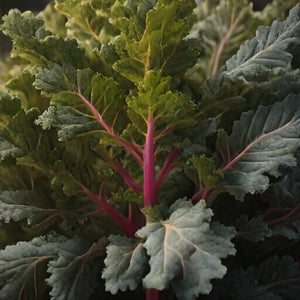- Hardiness Zone: 3-11 Biennial Often Grown As An Annual
Seed Depth: 1/4–1/2 inch
Seed Spacing: 12–18 inches
Row Spacing: 18–24 inches
Sunlight: Full sun to partial shade
Days to Sprout: 5–10 days
Days to Maturity: 50–60 days
Growth Habit: Upright, leafy biennial grown as an annual
Sunlight: Thrives in full sun but tolerates partial shade, especially in warmer climates.
Soil Type: Prefers rich, well-drained soil with a pH of 6.0–7.5. Adding compost improves soil fertility.
When to Plant: Sow seeds outdoors in early spring or late summer for a fall crop. For an earlier harvest, start seeds indoors 6–8 weeks before the last frost.
Direct Sowing: Plant seeds 1/4–1/2 inch deep, spacing them 12–18 inches apart. Thin seedlings to ensure proper spacing.
Indoor Sowing: Start seeds in trays and transplant when seedlings are 4–6 inches tall.
Succession Planting: Sow every 2–3 weeks for a continuous harvest during the growing season.
Watering: Keep the soil evenly moist, but not waterlogged, especially during dry periods. Mulch around plants to retain moisture and regulate temperature.
Fertilizing: Use a balanced fertilizer or compost at planting and mid-season to promote healthy leaf growth.
Pruning: Regularly harvest outer leaves to encourage new growth. Remove any yellowing leaves to maintain plant health.
Pest and Disease Control: Watch for cabbage worms, aphids, and flea beetles. Use row covers or organic pest control methods to protect plants.
When to Harvest: Harvest leaves when they are young and tender, typically 50–60 days after planting. Baby greens can be harvested earlier.
How to Harvest: Snip or gently pull outer leaves, leaving the central growing point intact for continuous harvests.
Seed Collection: Allow plants to bolt in their second year to produce seeds. Collect seeds from dry pods.
Storing Seeds: Store seeds in an airtight container in a cool, dry place.
Why You’ll Love It
Red Russian Kale is a beloved heirloom for its beautiful appearance and exceptional eating quality. The deeply lobed, blue-green leaves are tinged with purple and grow on striking violet stems. Unlike curly kale, Red Russian has a tender texture and a milder flavor — especially after a light frost. It’s fast-growing, cold-hardy, and great for harvesting as baby greens or full-size leaves. A must-have for fall and spring gardens.
Plant Characteristics
Height: 18–24 inches
Growth Habit: Upright, branching with open leafy tops
Leaf Type: Flat, deeply lobed blue-green leaves with purple veins and stems
Days to Maturity: 50–60 days (25–30 for baby leaves)
Hardiness: Cool-season biennial grown as an annual
Flavor and Culinary Uses
Flavor: Mild and sweet, especially after frost — more tender than curly varieties
Culinary Uses: Excellent sautéed, added to soups and stews, or eaten raw in salads when young. Great for kale chips or juicing.
Companion Planting Tips
Good Companions: Beets, celery, onions, chamomile, and dill
Avoid Planting Near: Strawberries or other brassicas to reduce disease pressure
Bonus Benefit: Cold-tolerant and frost-sweetened — perfect for overwintering in mild climates or extending the harvest
Common Issues and Solutions
Aphids or Cabbage Worms: Use floating row covers and attract beneficial insects like ladybugs
Tough Leaves: Harvest regularly and before full maturity for tender texture
Bolting in Warm Weather: Best planted in early spring or late summer for fall harvests
Seeds Per Packet
| 1g | Approximately 285 |
| 3g | Approximately 855 |
| 5g | Approximately 1,425 |
| 7g |
Approximately 1,995 |
Why You’ll Love It
Red Russian Kale is a beloved heirloom for its beautiful appearance and exceptional eating quality. The deeply lobed, blue-green leaves are tinged with purple and grow on striking violet stems. Unlike curly kale, Red Russian has a tender texture and a milder flavor — especially after a light frost. It’s fast-growing, cold-hardy, and great for harvesting as baby greens or full-size leaves. A must-have for fall and spring gardens.
Plant Characteristics
Height: 18–24 inches
Growth Habit: Upright, branching with open leafy tops
Leaf Type: Flat, deeply lobed blue-green leaves with purple veins and stems
Days to Maturity: 50–60 days (25–30 for baby leaves)
Hardiness: Cool-season biennial grown as an annual
Flavor and Culinary Uses
Flavor: Mild and sweet, especially after frost — more tender than curly varieties
Culinary Uses: Excellent sautéed, added to soups and stews, or eaten raw in salads when young. Great for kale chips or juicing.
Companion Planting Tips
Good Companions: Beets, celery, onions, chamomile, and dill
Avoid Planting Near: Strawberries or other brassicas to reduce disease pressure
Bonus Benefit: Cold-tolerant and frost-sweetened — perfect for overwintering in mild climates or extending the harvest
Common Issues and Solutions
Aphids or Cabbage Worms: Use floating row covers and attract beneficial insects like ladybugs
Tough Leaves: Harvest regularly and before full maturity for tender texture
Bolting in Warm Weather: Best planted in early spring or late summer for fall harvests
Seeds Per Packet
| 1g | Approximately 285 |
| 3g | Approximately 855 |
| 5g | Approximately 1,425 |
| 7g |
Approximately 1,995 |






Share and get 15% off!
Simply share this product on one of the following social networks and you will unlock 15% off!